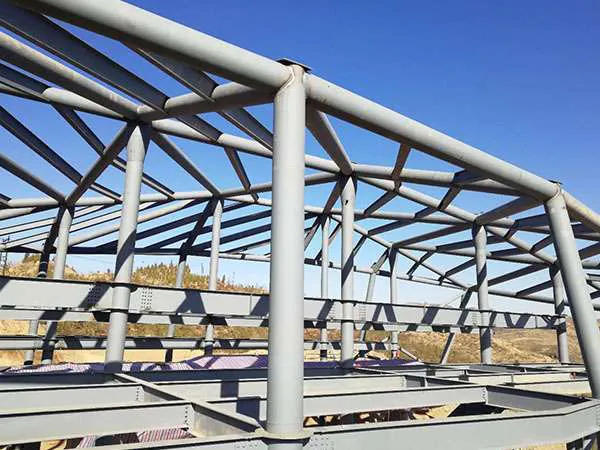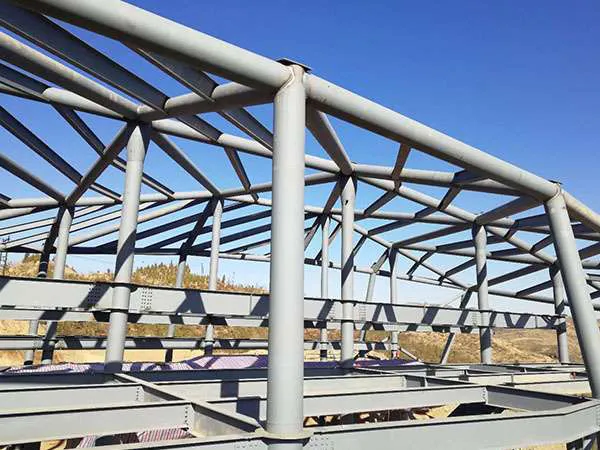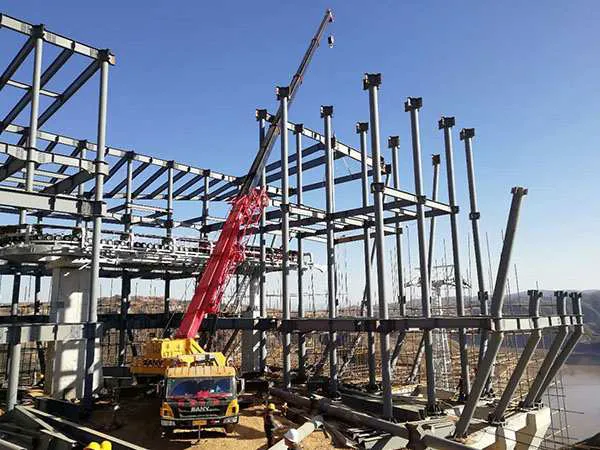Time:2025-08-22 03:04:06 Source:Sanjian Meichen Steel Structure
In modern architecture and industry, steel structures, with their advantages of high strength, lightweight, and rapid construction, occupy a central position. However, over time, due to changes in usage and environmental influences, steel structures also face challenges such as aging, damage, and insufficient load-bearing capacity. Professional reinforcement and retrofitting of steel structures can not only effectively extend their service life and improve safety, but also recreate asset value. This article will delve into the latest methods, key technical points, and successful practices in steel structure reinforcement and retrofitting, aiming to provide comprehensive guidance and forward-looking insights for engineers, owners, and related professionals.
Reinforcing and renovating steel structures is a critical field in civil and structural engineering, aimed at extending a structure's service life, increasing its load-carrying capacity, repairing damage, or adapting it for a new use. The methods range from traditional techniques to modern advanced composites.
Why are reinforcement and retrofit necessary?
Structural Aging and Damage: Long-term exposure to complex environments can cause corrosion and fatigue damage to steel, and welds or bolted connections may loosen or crack.
Design Standard Upgrade: Existing structures may not meet the latest seismic, wind, or other design specifications.
Use Change: Changes in the original design use, such as from light to heavy loads, or the addition of floors or equipment, can result in insufficient bearing capacity.
Disaster Repair: Damage to structures caused by natural disasters or accidents such as earthquakes, fires, and floods requires restorative reinforcement.
Improving Durability and Safety: Preventive reinforcement is performed to extend the service life of the structure and enhance its resilience to risks.
Energy Saving and Environmental Protection: Energy-saving upgrades such as insulation and sound insulation can be implemented in conjunction with retrofits, or green reinforcement materials can be used.
Core Objectives
The ultimate goal of steel structure reinforcement and retrofit is to maximize its reliability, cost-effectiveness, and serviceability while ensuring structural safety, while minimizing the impact on existing production or daily life.
Accurate diagnosis is crucial before reinforcement is performed. Common steel structure damage includes:
Component damage: including bending deformation, buckling deformation, fracture, fatigue cracks, etc.
Connection damage: weld cracking, loose or sheared bolts, and rivet failure.
Corrosion damage: surface rust and weakened sections of steel.
Coating degradation: detachment or failure of anti-corrosion and fire-resistant coatings.
Diagnostic methods:
Visual inspection: The most direct observation method, detecting obvious deformation, cracks, and rust.
Non-destructive testing (NDT): Ultrasonic testing, magnetic particle testing, and radiographic testing are used to detect internal defects.
Load testing: Applying test loads to structures or components to assess their actual load-bearing capacity.
Finite element analysis (FEA): Developing structural models to simulate stress distribution and deformation under load.
Material property testing: Sampling steel for tensile and impact testing to obtain actual mechanical properties.

Modern steel structure reinforcement technologies are becoming increasingly diverse and sophisticated, tailored to different damage types and reinforcement requirements.
3.1 Component Reinforcement Technology
Sectional Reinforcement Method (Section Enlargement Method):
Principle: By welding or bolting steel plates or steel sections to the surface of the existing component, the effective cross-sectional area of the component is increased, thereby improving its load-bearing capacity, stiffness, and stability.
Innovative Practice: Using high-strength steel plates and lightweight, high-strength composite materials (such as carbon fiber reinforced polymer (CFRP)) to replace traditional steel reduces deadweight and improves efficiency. Prestressed steel plate reinforcement technology can also effectively improve stress conditions.
Applicable Scenarios: Load-bearing components such as beams, columns, and trusses have insufficient bending, compression, or tensile bearing capacity.
Prestressed Reinforcement Method:
Principle: Applying prestress to the component alters the existing stress distribution, offsetting some of the stress generated by external loads, thereby improving the component's crack resistance, stiffness, and load-bearing capacity.
Innovative Practice: Using external prestressed cables or rods, combined with new anchoring techniques, facilitates construction and achieves significant results.
This method is particularly suitable for controlling deformation in long-span beams or trusses.
Applicable Scenarios: Long-span beams, trusses, wind-resistant columns, and other structures requiring increased stiffness and limited deflection.
3.2 Connection Node Reinforcement Technology
Additional Connectors:
Principle: Add high-strength bolts, rivets, or a bolt-weld combination to improve the load-transmitting capacity and ductility of the connection.
Innovative Practice: Introducing friction-type high-strength bolt connections, which transmit shear forces through friction generated by preload, resulting in highly reliable and removable connections.
Applicable Scenarios: Weld cracks, loose bolts, and insufficient bearing capacity of connecting plates.
Welding Repair and Reinforcement:
Principle: After cleaning and removing defects in existing welds, repair them using a new welding process or add a cover weld in place of the existing welds.
Innovative Practice: Utilize advanced technologies such as robotic welding and laser welding to improve welding quality and efficiency and reduce human error.
Applicable Scenarios: Weld defects and weld fatigue damage.
3.3 Strengthening the Overall Structural System
Adding Support or Seismic Components:
Principle: Adding shear walls, support members (such as K-braces and herringbone braces), or dampers to the structural system improves the overall stiffness, stability, and seismic performance of the structure.
Innovative Practice: Introducing new energy dissipation and vibration reduction devices such as buckling-restrained braces (BRBs) and viscous dampers to dissipate seismic energy while providing stiffness.
Applicable Scenarios: High-rise steel structures with insufficient seismic capacity and lateral stiffness.
Changing the Structural Force Transmission Path:
Principle: Through local modifications, the load transmission path within the structure is adjusted to distribute the load to areas with greater load-bearing capacity or avoid weak links.
Innovative Practice: For example, partially converting the original frame structure to a frame-support structure optimizes force transmission.
3.4 Application of New Materials and Technologies
Carbon Fiber Reinforced Polymer (CFRP) Reinforcement:
Features: High strength, lightweight, corrosion-resistant, and easy to construct. Application: Replacing steel plates for reinforcing flexural and tensile members, particularly suitable for structures in corrosive environments or with strict deadweight requirements.
Steel-Concrete Composite Structure Reinforcement:
Features: Leveraging the compressive strengths of concrete and the tensile strengths of steel to improve overall stiffness and load-bearing capacity.
Application: Laying concrete slabs on steel beams to form composite beams, or wrapping concrete around steel columns to form steel-concrete columns.
Intelligent Monitoring and Maintenance System:
Features: Using sensors to monitor structural health in real time, such as strain, displacement, vibration, and corrosion, provides data support for reinforcement decisions and enables long-term safety assessment of reinforced structures.
Application: Combining big data analysis and artificial intelligence to predict structural deterioration trends and implement preventative maintenance.

Renovation and renovation involve more than just reinforcement; they also involve functional upgrades, aesthetic enhancements, and green and sustainable development.
4.1 Functional Renovation
Spatial Layout Optimization: Optimize interior space by removing or modifying non-load-bearing components or adding mezzanines or platforms.
Load Capacity Enhancement: Comprehensively assess and improve the load-bearing capacity of relevant areas for newly added equipment or functions.
Traffic Flow Improvement: Add stairs, ramps, elevators, and other systems to optimize the efficient flow of people and materials.
4.2 Aesthetic and Environmental Renovation
Exterior Facade Renovation: Incorporate new curtain wall systems and sunshades to enhance the building's aesthetics and energy efficiency.
Interior Decoration and Lighting: Utilize new materials and lighting designs to improve indoor comfort.
Green Roofs and Vertical Greening: Improve the building's thermal performance and enhance its ecological value by adding greenery to roofs or walls.
4.3 Sustainable Renovation
Material Recycling: Dismantled steel can be recycled and reused, reducing resource consumption. Energy-saving renovations: Strengthen the building envelope's thermal insulation and upgrade to a high-efficiency HVAC system.
Renewable energy integration: Install solar photovoltaic panels and rainwater harvesting systems to reduce operational energy consumption.

Quality and safety must be prioritized in any reinforcement and renovation project.
Strict design review: Ensure the rationality, reliability, and cost-effectiveness of the reinforcement plan.
Material inspection: All incoming materials must comply with national standards and design requirements.
Construction process monitoring: Fully supervise key processes such as welding, bolting, and concrete pouring.
Safety management: Develop a detailed safety construction plan, including procedures for working at height, fire prevention, and edge protection.
Completion acceptance and post-maintenance: Ensure the reinforcement and renovation results meet expectations and establish a regular inspection and maintenance mechanism.
Project Name: XXXX Industrial Plant Expansion and Load Capacity Improvement Project
Challenge: The existing single-story steel structure factory building needed to be renovated into two stories, increasing the installation space for large equipment.
This resulted in a significant load-bearing capacity deficit for the existing roof trusses and columns, and the construction was required to maintain consistent production on the ground floor.Solution:
The existing steel columns were reinforced with externally enclosed steel sections to improve their axial compression and bending resistance.
Lightweight, high-strength steel beams were added to the lower chord of the existing roof trusses, supplemented by prestressed tie rods to share the load of the newly added second-floor slab.
Prefabricated steel floor slabs were used to reduce wet work, shorten the construction period, and minimize the impact on production.
Optimized ventilation and lighting design were implemented to introduce natural light and improve the working environment.
Result: The factory building successfully upgraded its functionality and increased its load capacity, expanding production space while effectively controlling construction costs and time.
With the in-depth application of Building Information Modeling (BIM), digital construction, high-performance materials, and artificial intelligence technologies in the engineering field, steel structure reinforcement and renovation will become more intelligent, efficient, and sophisticated. Green construction and sustainable development concepts will further guide reinforcement and renovation technologies toward low energy consumption and low emissions.
Steel structure reinforcement and renovation are crucial for ensuring building safety, extending their lifecycles, and achieving sustainable development. By thoroughly understanding its necessity, mastering advanced technologies, and implementing rigorous process control, we can breathe new life into aged or damaged steel structures, enabling them to continue serving socioeconomic development. It's crucial to select a professionally qualified and experienced steel structure engineering company that can provide comprehensive solutions from diagnosis and design to construction.